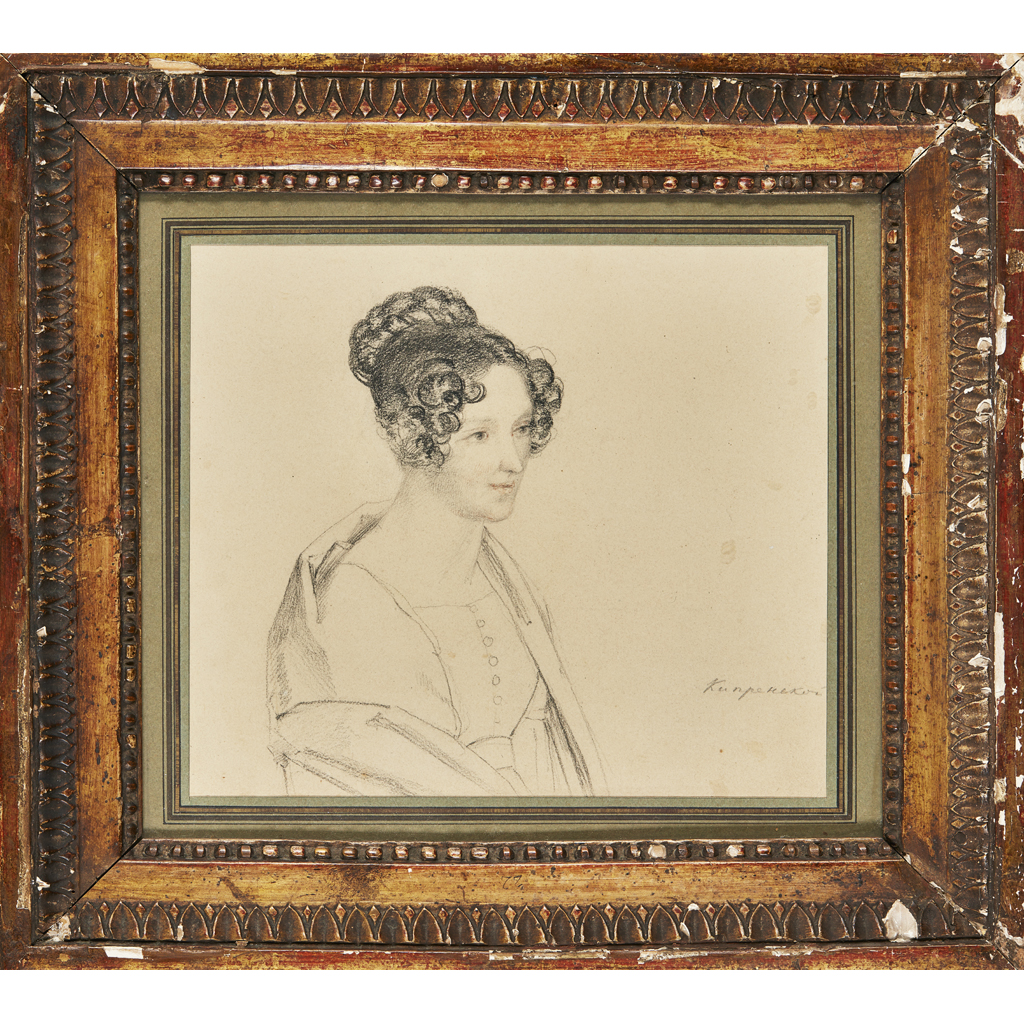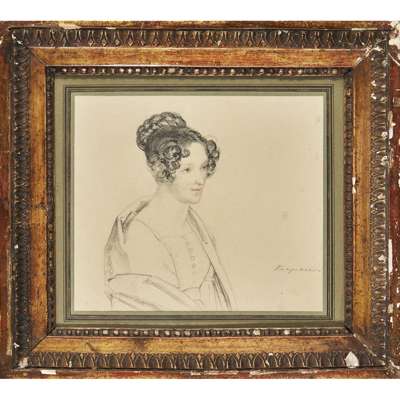
Lot 124

OREST ADAMOVICH KIPRENSKY (RUSSIAN 1782-1936)
PORTRAIT OF A YOUNG WOMAN SAID TO BE AMELIE ADLERBERG


Fine Furniture and Works of Art
Auction: 25 January 2017 at 11:00 GMT
Description
inscribed, and inscribed verso, coloured chalk
Dimensions
21.5cm x 24.5cm (8.5in x 9.75in)
Footnote
Provenance: Russian Works of Art from the Collection of The Late Jan Bethge Esq.
Note:
AMALIE ADLERBERG (1808-1888)
Born in June 1808 in Darmstadt, Amelie Lerchenfeld was the illegitimate daughter of Duchess Therese of Mecklenburg-Strelitz and the Bavarian diplomat Maximilian-Emmanuel Graf von und zu Lerchenfeld auf Köfering und Schönberg.
Amalie's mother was the aunt of Empress Alexandra Feodorovna (Princess Charlotte of Prussia), the wife of the Russian Emperor, Nicholas I.
With her husband away working for Napoleon in Paris, Princess Therese had an affair with Count Maximilian-Emmanuel von Lerchenfeld and Amelie was the result. With the death of her father in 1809, Amalie was placed in the care of Therese's von Sternfeld relatives in Hesse/Darmstadt and took their name. Later, with her name now changed to Satrgard, she was taken up by her father's family, moving to the Lerchenfeld Palace in Munich and their castle at Regensburg. Finally, formally granted the name Von Lerchenfeld in 1823, at the age of 15, she settled in Munich.
While there, she met Fyodor Tyutchev - the celebrated Russian poet, then a junior diplomat. Tyutchev fell in love with Amalie and dedicated numerous poems to her. Despite their mutual love, in 1825 Amelie married an older man, Baron Alexander von Krüdener (1786-1852), a wealthy, titled diplomat and effectively Tyutchev's superior. Nevertheless, Tyutchev and Amalie continued to see each other and their tortured affair continued.
In Munich in the late 1820s Amelie became a society beauty. King Ludwig I of Bavaria was 'spellbound' by her and ordered her portrait to be painted by Joseph Stieler in 1828.
In 1836 Krudener was promoted and the couple moved with their young family to Saint Petersburg. There she promoted Tyutchev's poetry, gaining the attention of Sergey Pushkin, editor-in-chief of Sovremennik, the major literary journal of nineteenth-century Russia, which published many of the poems.
Amalie became well known in Saint Petersburg society. Tzar Nicholas himself was captivated by her, and, although no clear evidence of a relationship exists, we do know that Amalie received presents from him, including a fur coat.
In 1848, following an affair with Count Nikolai Adlerberg, Amelie gave birth to an illegitimate son. While her husband was promoted to Ambassador to the King of Sweden and Norway, Amelie now chose to remain in St Petersburg. They never met again and following Krudener's death in 1852, Amelie married Adlerberg in 1855.
She devoted her later life to charitable works, opening an orphanage and living in Helsinki with her husband, then Governor General of Finland, before settling in Munich where she died in 1888.
OREST KIPRESNKY (1782-1836)
Orest Adamovich Kiprensky was a prominent Russian Romantic artist. Born near St Petersburg in 1782, the illegitimate son of a landowner, he was raised as a serf but with the help of his natural father, from the age of six, studied at the Imperial Academy of Arts in St Petersburg. Following considerable acclaim, and a further period of study in Naples, Kiprensky settled in Moscow from 1809 and from 1812 in St Petersburg. In mid-May 1816, having been appointed Adviser to the Academy of Arts, he was given state support to travel to Italy and, from 1816 to1822 lived in Rome and Naples.
While in Rome he was involved in a scandal involving the death of one of his life models, a girl named Mariucci, who was found dead in Kiprensky's quarters. A few days later, in a local hospital, Kiprensky's servant, a young man, also died. Kiprensky maintained that the model had been murdered by the servant, but some said that he himself had committed the murder. With the police unable to solve the crime, Kiprensky placed the murdered girl's ten year old daughter Anna Maria in a convent and left Rome for Paris, but with the story becoming more widespread, in 1823 he moved on to Russia.
It would appear to have been during this journey that he might have had the opportunity to make the drawing of Amelie Adlerburg which forms the current lot, either at Munich, Regensburg or at the spa town of Marienbad where we know he paused en route for Russia, making two drawings of Goethe.
Back in Russia, from 1823, Kiprensky continued to pay for Anna Maria Mariucci's upkeep and in 1828 he took her on as his ward.
Seven years later, returning to Rome, on meeting the now 17-year-old Anne Maria, he fell in love with her. Although 36 years her senior, he converted to Catholicism and in 1836, married her. Sadly however, the marriage was not happy and three months later, Kiprensky died of pneumonia. A few months later, Kiprensky's daughter Clotilde was born and Mariucci subsequently sold her inheritance - a large number of her husband's works - to the St Petersburg Academy of Arts.

